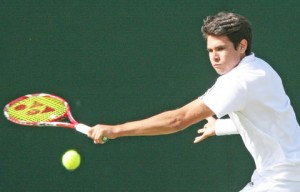
By JOHN MARTIN
WIMBLEDON, England — Lucas Gómez, the Mexican national junior tennis champion, was humbled at the French Open in early June. He was beaten, 6-1, 6-0, in the third round of the junior tournament by second-seeded Nikola Milojevic of Serbia after expressing strong belief in his ability to win.
“He doesn’t have anywhere to attack me,” Gómez, 17, said the day before the match. “I’m feeling confident about that.”
The loss wounded Gómez’s spirit, said Angélica Gavaldón, his coach. She said she conveyed to him that “6-1, 6-0 is just not acceptable.” The comment stung but worked, Gómez acknowledged.
Two weeks later, he upset top-seeded Wayne Montgomery to win the Gerry Weber Open junior grass-court championship in Halle, Germany.
“Sometimes it takes a match like that to make him realize that he needs to toughen up,” Gavaldón said in a telephone interview from San Diego, where Gómez travels to train from his home across the border in Tijuana.
For Gavaldón, a top-30 player in the 1990s, Gómez’s victory in Halle seemed to reinforce her belief that he has a remarkable drive to overcome adversity. “He’s been through a lot,” she said.
On May 27, 2006, Gómez; his father, Manuel; and a group of junior tennis players were on a bus in Mexico City on the way to an airport when a gunman shot to death Manuel Gómez, a lawyer in Tijuana, with Lucas, then 10, sitting beside him. No motive emerged.
“It’s a mystery,” Gavaldón said, “We don’t know what happened.”
Gómez said, “I try not to think about it.”
Family friends said that his pain was deep but that he emerged from the ordeal swiftly and with remarkable determination.
“Right after it happened, that week, he actually won a tournament,” Gavaldón said, “His dad was very involved with tennis, and the dad was a really good player himself. His tennis was his thing with his dad.”
In an interview at Roehampton, where he was training for the Wimbledon junior championships, Gómez said: “Maybe I was too young to realize what it really was. Maybe if I would have been older I would have been more conscious about it, maybe it would have been worse. But, I mean, I got over it.”
Two days later, Gómez was scheduled to face 14th-seeded Guillermo Nunez, 17, of Chile, in a first-round junior match at the All England Lawn Tennis Club.
Asked how his father might have viewed his presence at Wimbledon, Gómez said: “That’s definitely the thing that gives me the most satisfaction, is that hopefully my dad, he’s watching or he knows what I’m doing. I can just imagine how he would feel.”
His father’s loving pressure to play tennis, Gómez said, was a gift many players his age never received.
“He gave me, in some ways, everything,” he said. “If it wouldn’t have been for him, 7, 8, 9, 10 years ago, when I started playing tennis, nothing of this would have ever happened.”
Gómez said his sister, Isabelle, 14, recently e-mailed photos of him with his father.
“I was 5 or 6 years old,” he said. His father was “feeding me balls with his hand, dressed in a suit like he was going to work.”
Gómez smiled. “I was very disobedient,” he said. “He would tell me every single point, ‘Move your feet!’ Kids at 10, kids at 9, they don’t want to go train two hours a day, one hour a day, hitting balls.”
Soon, however, “I started liking it, when I started winning,” he said. “This would never have happened. It’s all due to him.”
Gómez is not the first Mexican junior to rise in the international tennis ranks from Tijuana, a metropolis of 1.7 million.
In 1995, Alejandro Hernández, 17, reached the semifinals of the Wimbledon junior championship and the quarterfinals of the United States Open junior championship, earning a ranking of 10th in the world.
During an 11-year professional career, Hernández earned a top ranking of 125th in 1997, and scored early victories over Gustavo Kuerten, later a three-time French Open champion, and Juan Martín del Potro, the 2009 United States Open champion.
Gómez, by comparison, has risen steadily through the junior rankings, jumping last week to 28th from 47th after his victory at Halle.
“He’s really an aggressive baseliner,” said Angel Lopez, who coached Gavaldón, an Australian Open quarterfinalist in 1990 and 1995, and Zina Garrison, a Wimbledon finalist in 1990.
“He fights hard,” added Lopez, who mentored Gómez on an all-star team of American juniors in San Diego in 2008. “I think his serve is a little suspect, but he’s left-handed, and his serve has improved.”
Gómez agreed.
At Halle, Gómez said, “I got broken maybe three times in the whole tournament.”